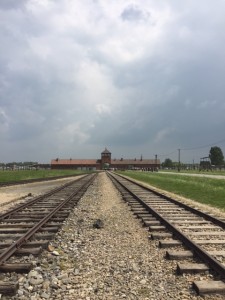I have wanted to visit Auschwitz for years. That may seem a little strange, but I have been reading memoirs, fiction, and nonfiction books about the Holocaust for the past ten years. I have always found it fascinating and disturbing, and I have always wondered how the world could have let this terrible thing happen. As a young child, I was confused by the brutality. Justice and equality have always been important to me, so the rampant anti-semitism in Europe during World War II was, and still is, hard to wrap my head around. When I found out that this trip would give me the opportunity to see Auschwitz and maybe get some answers, I was excited but scared. Visiting a place where 1.1 million people brutally died is terrifying. When we finally arrived there, these feelings only intensified. There were school groups laughing, tour guides directing people, and places to get food. I was confused: Where was the Auschwitz that I had read about, the one I had pictured in my head and seen in movies? Then we entered the infamous gate, “work will make you free,” and the guided tour began. We walked the streets that the prisoners had walked, saw the jail cells where they were tortured, and saw the piles of stolen hair, glasses, and shoes. I was floored. I had known most of the information already and knew that these places existed, but seeing them in person was much different and very powerful. Then we went to Auschwitz-Birkenau, and I saw the train tracks and entrance that are shown in many movies. It was astounding and devastating as we walked through and saw the tiny train car in which at least sixty or more Jews were packed like sardines, and then we walked down the path towards the gas chambers, the same path that was walked by the Jews who did not “pass selection.” The Nazis destroyed the gas chambers at the end of the war in an effort to cover their tracks, but of course the world discovered the truth through the testimonies of survivors and documents and buildings that survived. We also saw barracks where prisoners were kept while waiting to be murdered in the gas chambers. They were forced to stay there for a few weeks without food and water because they were unable to work and therefore considered already dead. In these barracks, we saw graffiti done by uncaring and self-centered tourists. This made me incredibly angry because doing graffiti in a place where unjustly imprisoned people were starving to death is horrific, disgusting, and disrespectful.
Visiting Auschwitz made me realize that Germany’s “Final Solution” was truly systematic and completely destructive. The Nazis were very good at killing thousands of people quickly and efficiently, and they were also good at destroying the human spirit. Our tour guide described the prisoners as walking skeletons, but I don’t think that was just in reference to food. In order to be a walking skeleton, there has to be no personality or spark of life left. The Nazis were successful at this method of complete destruction, but of course there were survivors. Of the 1.3 million people that were imprisoned at Auschwitz, 1.1 million were murdered.
This is a tragedy that could have been avoided, or at least lessened. Many countries made tragic mistakes before and during World War II, including France, Germany, and the U.S. The Vichy government in France deported thousands of Jews and completely collaborated with the Nazis, with the support of the majority of the French people. They liked the newly appointed leader of France, General Pètain, and anti-semitism was already an issue before the Germans took control. The German people were brainwashed by the Nazis for years before the Holocaust even began, so it is almost understandable how they embraced and encouraged anti-semitism. The United States refused to take as many refugees as was needed, perhaps because they didn’t understand the gravity of the situation, or because they refused to believe it. The U.S. government forced Jews to remain in Nazi occupied territory, where they were abused, robbed, deported, and killed. It is crucial that the world learns all they can from the Holocaust in order to prevent a similar atrocity from ever happening again.


